Las Cumbres Observatory Connects Us to the Cosmos
Headquartered in Goleta, the World’s First Global Telescope Network Is Now Opening Eyes and Blowing Minds
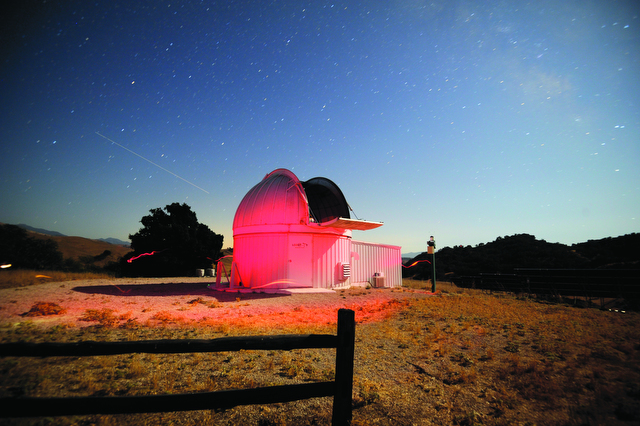
Just as the sun never set on the British Empire, today it never rises on the Las Cumbres Observatory. “We keep you in the dark,” its founder Wayne Rosing is fond of saying.
Rosing, a godfather of early computing, who made a fortune at Apple and Google, was always an admitted space junkie. He had long puzzled over a major dilemma facing astronomers studying the cosmos: Telescopes, no matter how large, could only view a narrow, stationary window into the universe. As the Earth turned and clouds drifted, the night sky disappeared.
In the early 1980s, Rosing began to envision a connected network of telescopes, even relatively small ones, which would allow for 24-hour examination of the stars. This would be a critical tool to study fast-moving and one-time events such as an asteroid whizzing past Earth or a supernova exploding thousands of light-years away. But back then, the technology didn’t exist for such an expansive undertaking; the Internet as we know it was still a decade away.
By 2005, the world of technology had caught up with Rosing’s dream. He was living in Montecito, so he decided to start Las Cumbres Observatory (LCO) in a Goleta office park, next to UCSB and its world-class science departments. It was not hard to find young engineers and astronomers hungry to innovate. Nine years and more than $100 million later, the LCO network sprang to life.
Today, LCO has 18 telescopes strung across the globe in Chile, Australia, South Africa, Maui, Texas, and the Canary Islands, streaming oceans of invaluable images and data through its open-source network to scientists from China to Israel. Even schoolkids in Goleta and London can train LCO’s lenses on glittering galaxies for their science fair projects.
Until recently, few people outside the insular ranks of professional astronomy had heard of LCO. That was by design. Their scientists and engineers worked quietly in the Cortona Drive offices, creating this vast, revolutionary project. Slowly, during the last year, the observatory has been introducing itself to Santa Barbara and the rest of the world. Through public talks and kids’ camps, its scientists are explaining how and why LCO became the leader in what’s known as “time domain” astronomy, and what implications that will have for understanding our place in the stars.
It turns out LCO employees are a gregarious lot who take honest joy in talking to laypeople about the universe. And their efforts come at a fortuitous time, when the public’s interest in space has been piqued by a number of astonishing discoveries — stars ripped apart by black holes, dark energy stretching the universe beyond what we thought possible, and, most amazingly, the detection of a planet in our galactic backyard that might support life. LCO has played a part in it all.
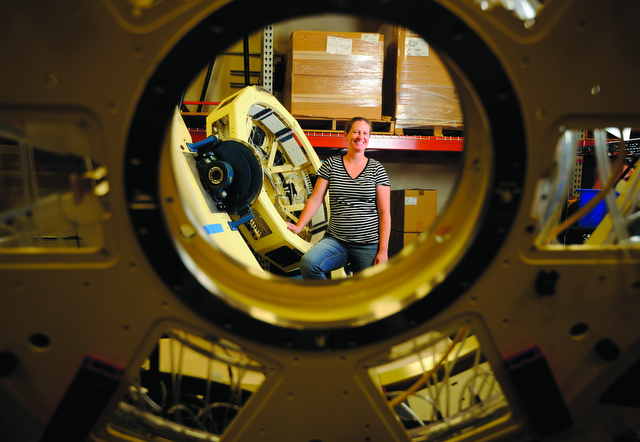
From Dusk ’til Dawn
“In the early days, we were in the building constantly,” remembered operations manager Annie Hjelstrom. “We were all young and single. We had nothing else to do, and we were really excited about what we were working on.”
Hjelstrom majored in aerospace engineering and minored in astrophysics, an area of science typically dominated by men. After graduation, she joined the Peace Corps in the Pacific Island nation of Vanuatu, teaching students car mechanics where there are no cars, and how to work a computer that was being powered by a generator. While deciding what to do next, Hjelstrom came across an LCO internship on Craigslist. Like many of her colleagues, Hjelstrom didn’t have any telescope experience when Rosing hired her. “Maybe he wanted us to approach the project with fresh eyes,” she said.
Long gone are the days of Galileo, when astronomers peered through one end of a telescope and found planets out the other. Today most telescopes are robotic with imaging sensors, similar to a digital camera. LCO started with a commercial-brand frame and then engineered its own internal components. Beginning with 0.4-meter telescopes, the staff tested early creations in their parking lot, where they battled South Coast fog and light pollution. Once they had the 0.4-meter dialed in, they upsized the process to 1 meter and 2 meters, now their largest telescopes.
A telescope’s size refers to the diameter of its primary mirror. “Imagine the mirror is like a bucket,” explained Hjelstrom. “The bigger the bucket, the more light you can catch, and the fainter the objects you can see.” Compared to other professional telescopes, 2 meters is on the smaller end. For example, UCSB Chancellor Henry T. Yang is part of an effort to build a 30-meter monster in Hawai‘i. “But what we can’t accomplish in size we’re attacking with the network and sheer numbers,” said Hjelstrom.
Hjelstrom has overseen many of LCO’s telescope installations, including those in Texas, Chile, and South Africa. Now she and her team are figuring out how to move two 1-meter units to a Tibet mountain. It won’t be easy. The site is 17,000 feet high and is -20 degrees in the winter. Their goal is to have the telescopes up and running by next summer. Then, they plan to deploy two more to the Canary Islands and another to Texas in order to fill out the network’s remaining blind spots, all in the Northern Hemisphere. The system then will truly connect the entire sky from the ground, allowing us Earthlings to see the stars no matter where we live, 24 hours a day. Whether we’re in Boston or Beijing, LCO will find us the night.
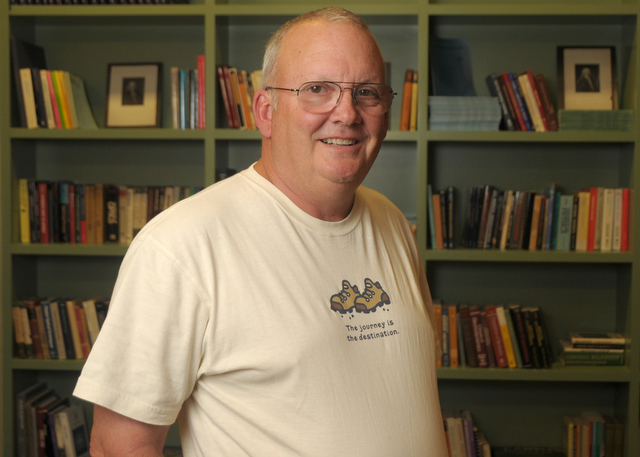
To What End?
Overseeing the entire LCO operation is the fast-talking and perpetually busy Todd Boroson, who arrived two and a half years ago from the National Optical Astronomy Observatory in Tucson, one of the foremost institutions in U.S. astronomy. When he first heard about the director’s job, he was skeptical — LCO looked like a millionaire’s lark. He didn’t want to work for a Richard Branson or Jeff Bezos, who, seemingly bored with Earth, have dumped their fortunes into interstellar vanity projects. “But when I visited, I realized, wow, this is more than just another ‘rich guy telescope,’” Boroson said. “This is something no one’s ever thought of doing.”
LCO’s in-house scientists study gamma bursts, track comets, spy on exoplanets, and so on, but other scientific organizations and individuals can book time on the network for their own observations. LCO has become so famous among astronomers that the company is flooded by requests. Each must be vetted and prioritized, before being scheduled by LCO’s unfathomably complicated software. It also sells hours to agencies such as the National Science Foundation, and to private companies to help track their satellites. It’s a one-of-a-kind business model. Boroson estimated LCO has sold half a million dollars’ worth of telescope time in the first six months of this year alone. Depending on availability and telescope size, the network charges from $125 to $700 an hour.
Last year, Rosing, who had been funding LCO entirely out of his own pocket, turned over financing responsibilities to a development team. As a nonprofit, they must now raise in the neighborhood of $3 million a year in grants and donations to continue their work. It’s a daunting but not impossible task, given the passion and brainpower at LCO, said Boroson.
The field of astronomy is transitioning from mostly static observations to more time domain surveys. “Many of the things we’ve studied for the last hundred years really don’t change much over a person’s lifetime, much less over a few days,” Boroson said. “Now, we’re discovering that if you continually study an event, say a supernova that changes by the minute, you can get a lot more information.”
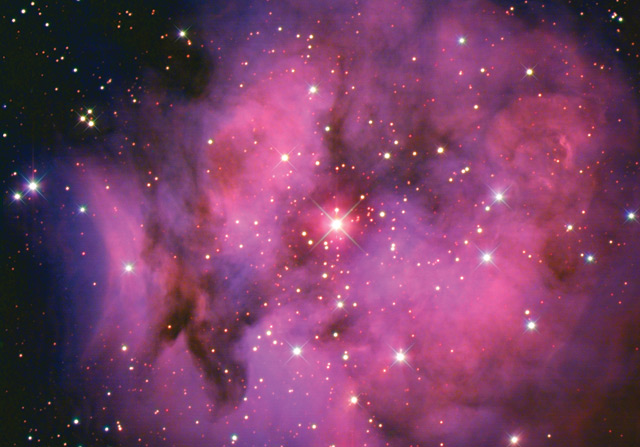
Why study these things? For one, a supernova — a massive star that exhausts its fuel and then collapses in an exploding flash as bright as 10 billion suns — “is involved in making the elements that are inside all of us,” explained LCO staff scientist and UCSB adjunct professor Andy Howell. While hydrogen and helium were created in the Big Bang, supernovae are responsible for the iron in our blood and the calcium in our bones. Carl Sagan once said, “We are made of star stuff.” And, Howell added, “We are also supernova stuff.”
Beyond that, watching distant supernovae revealed that the expansion of our 15-billion-year-old universe is actually speeding up, not slowing down, as we previously thought. The radical discovery, first announced in the late 1990s, led to the now widely accepted theory that what appeared to be empty space was not empty but filled with dark energy, a still mysterious force that repels gravity. Measurements show that dark energy accounts for 68 percent of all the substance in the universe. Twenty years after its discovery, however, researchers are still trying to figure out what exactly it is. That’s where LCO comes in, as the observatory is able to continually collect new, better data, from multiple supernovae without any downtime.
Supernovae happen quickly. “The star is blowing up in the time it takes you to sneeze,” explained Howell. The stuff that’s ejected moves at 30,000 kilometers a second, forcing the LCO network to adjust rapidly when one of these colorful galactic bombs goes off. “I’ve gotten an alert at dinner that we need observations right now, and I’m like, okay, here we go.”
Howell heads a group of 100 fast-response collaborators across the planet. They call themselves the Supernova Key Project, and their goal is to track 500 supernovae over three years. LCO also observes elusive tidal disruption events, when a star is torn apart by a black hole. One of LCO’s postdocs recently discovered an easier way of finding these colossal tug-of-wars — he found they tend to happen in an unusual type of galaxy with both old and young stars. “We’re really leading the world in this kind of research,” Howell said.
Heads Up!
In February 2013, before LCO was online, a 20-meter meteor blew up over a small Siberian town, at a force 30 times greater than the Hiroshima nuke. It shattered windows for miles and sent 1,500 people to the hospital. “No one saw it coming,” recalled LCO’s Tim Lister, who leads LCO’s Solar System Group. Astronomers were focused on a larger meteor careening within 17,500 miles of Earth — a hair’s width in space terms. It was a stunning reminder of what could — and has — happened.
Every night, search teams around the world survey the sky with wide-field cameras, looking for new asteroids and comets called Near-Earth Objects (NEOs). They always find a few hundred. Most are too small or too far away to be of any interest. Others are stuck in orbit in our solar system’s asteroid belt between Mars and Jupiter. But those that will come within 1.3 AU of Earth are measured and logged. (AU stands for astronomical unit, or 149.6 million kilometers, the distance from the Earth to the sun.) The searchers then turn over the information to LCO scientists, who assume a central role in tracking these NEOs, in collaboration with NASA and other observatories.
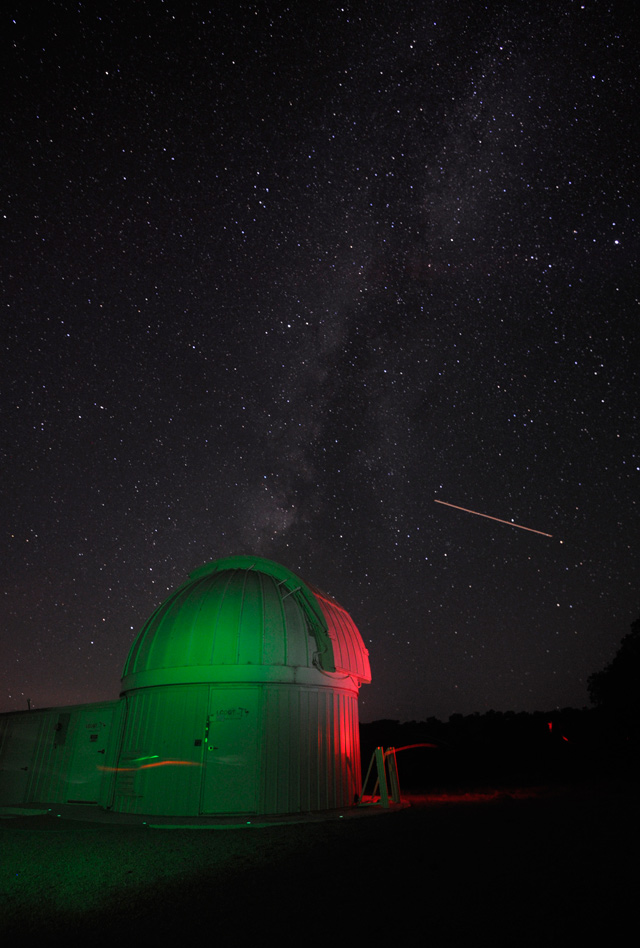
In all, 14,642 Near-Earth Objects have been discovered as of August 10; 1,720 have been classified as “Potentially Hazardous Asteroids,” meaning they’ll pass Earth within 0.05 AUs. Lister noted how in 1908, a small asteroid slammed into Siberia, rather than exploding above it. The impact leveled 1,000 square miles, wiping out 80 million trees. Sixty-five million years ago, a bigger rock took out the dinosaurs.
Lister, hardly an alarmist, explained that most NEOs have less than one in a million chance of hitting Earth. Still, NASA has its own Planetary Defense Coordination Office to warn the public of any threats, and it’s grateful of LCO’s eyes on the sky. “They’re a very productive group,” said Dr. Lindley Johnson with Planetary Defense. “And we certainly appreciate their help.”
Asteroids and comets aren’t just potential death dealers — they also offer remarkable insight into solar system evolution. “Asteroids are what’s leftover when you’re done making planets,” Lister said. “They allow you to see what was happening during those early stages of formation.” Comets delivered a lot of Earth’s water in its early history and have been shown to contain the very building blocks of life. The European Space Agency’s Rosetta spacecraft detected organic materials in an icy comet skirting Jupiter for the first time this May. LCO is able to supplement such findings with its own research.
LCO is also uniquely set up to use “gravitational microlensing” to discover planets outside our solar system, called exoplanets. Rachel Street heads up that crew. Very basically, Street explained, a microlensing event is when a planet moves between Earth and a background star. This subtly bends and magnifies the star’s light. Scientists can measure that blip to find cold, remote planets that would otherwise be impossible to spot. They’re the loners of the universe, but they may help explain how worlds form and interact with one another.
The overlap happens briefly and only once, so Street and her team are always on their toes. Like Howell, she often receives sudden notices that require immediate attention. LCO pinpoints around 2,000 microlensing events a year and then homes in on 10-15 planets for further study. Street recently coordinated with NASA’s Kepler mission to peer into the bulge of our galaxy. LCO was one of just a few organizations selected to participate in the landmark study, where hundreds of new exoplanets were discovered.
Street, who was raised in the U.K., had her interest in astronomy sparked when, as a child, she and her father would stand in their backyard and gaze up at the stars. Now Street takes great pride in LCO’s ability to connect with people new to astronomy. She works closely with her UCSB interns. “It’s a way of getting them into technical STEM subjects (Science, Technology, Engineering, and Mathematics) that they maybe wouldn’t have considered.”
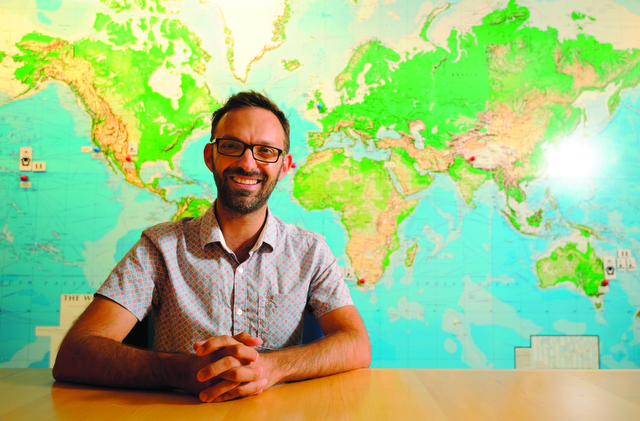
Be Curious
It’s Edward Gomez’s job at LCO to show kids and adults that astronomy isn’t impossible. As LCO’s education czar, he works to engage the public in tangible and meaningful ways. “People want to participate in science,” he said. “The idea that they can contribute to scientific discovery — that’s a very powerful thing.” Recently, Gomez created a program to track two different asteroids; participants’ observations factored directly into LCO’s final findings.
Gomez also just organized Camp Cosmos, where 60 kids aged 7-12 — half of them Santa Barbara Boys & Girls Club members — spent a week at LCO. They built robots and watched the scientists in action. At the end of the sessions, they hiked up to Sedgwick Reserve’s telescope to gaze at Saturn. The kids shrieked with excitement when they realized they could clearly see the gas giant’s luminous rings and glowing moons. “It was a phenomenal experience,” said Gomez.
Gomez, who lives in Wales but travels to Goleta a few times a year, admitted he’s had better luck connecting with educators in England and Australia than their U.S. counterparts. “Maybe they’re a bit intimidated,” he theorized. Goleta Valley High School has, however, tapped into the network for local and state science fairs. Other young students across the globe regularly post (and boast) online images of nebulas, quasars, and other celestial bodies they captured with LCO’s telescopes.
With additional funding, Gomez said, he hopes to expand LCO’s education arm, a small but central component of the organization since its inception. “Our overriding ambition is to make everyone realize they are a scientist,” he said. “The basis of science is just asking questions.” Elementary students are great at that. It’s as we get older that our curiosity fades. But, Gomez noted, it doesn’t take much to rekindle that wonderment.
A lot of wonderment ignited this week when, on August 24, LCO astronomers and an international team of scientists made a showstopper of an announcement about the search for life outside our solar system — a rocky planet, slightly larger than Earth, was found orbiting the nearest star to our sun. The newly discovered world, named Proxima b, lies within the so-called “Goldilocks zone” of its star, meaning it’s neither too hot nor too cold to support liquid water. That means it could be similar to Earth in other crucial ways, and be home to some form of Proximese alien. “Finding that our neighboring star system has a planet in the habitable zone really opens a new phase in planetary science,” said Street. “The dream of directly exploring an exoplanet has suddenly become tangible.”
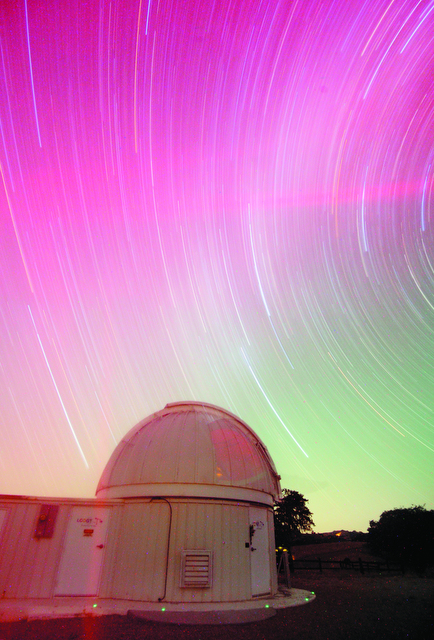
Meanwhile, a Yale astronomer, Dr. Tabetha Boyajian, recently raised $100,000 in a Kickstarter campaign to buy time on LCO’s network to study a bizarrely behaving star in the constellation Cygnus. Unusual light fluctuations from what’s been called the WTF star (for Where’s the Flux?) have given rise to the unlikely but titillating theory that an extraterrestrial mega structure is behind the otherwise unexplainable observations. Dr. Boyajian has vowed to watch that star until she gets a definitive answer.
For her money, Boyajian believes the strange light variations will be explained by some kind of natural phenomenon. “But don’t get me wrong; I think it’d be awesome to find aliens,” she said at a TED Talk in February. “Either way, there is something new and really interesting to discover.” Boyajian has credited citizen scientists for noticing WTF’s weirdness in the first place, and she’s counting on their help with backyard telescopes and through their own LCO network time to enhance her findings. She’ll visit Santa Barbara in December to give a public presentation of her work.
LCO is also hosting free and public Astronomy on Tap talks where beer-swilling stargazers get to geek out with the scientists themselves. This May 4, Howell stood onstage at a downtown nightclub dressed as Chewbacca for an LCO-sponsored “May the Fourth Be with You” event. Howell, accompanied by Cal grad student Chelsea Harris wearing a white robe and Princess Leia earmuff hair braids, downed shots of tequila while praising and lampooning the physics of the films. Harris wondered about the “space slug” that tries to swallow Han Solo’s Millennium Falcon. “What kind of animal evolves to eat space ships?” And Howell described how NASA’s Dawn space probe orbiting the dwarf planet Ceres between Mars and Jupiter uses the same ion engine technology as TIE Fighters. “So really,” he said, pausing for effect, “we have a TIE Fighter right now at Ceres.”
At the end of the night, standing at the bar, his Chewbacca suit half unzipped, Howell talked about how awestruck he was seeing Star Wars at a drive-in at age 4. That giddy amazement is still with him. He wants other grown-ups to feel it again, too. “You know,” Howell smiled, “interstellar travel might actually happen in our lifetime.”
For more on LCO, and to make your own discoveries, visit lcogt.net.

seen from LCO’s observatory in Chile.



